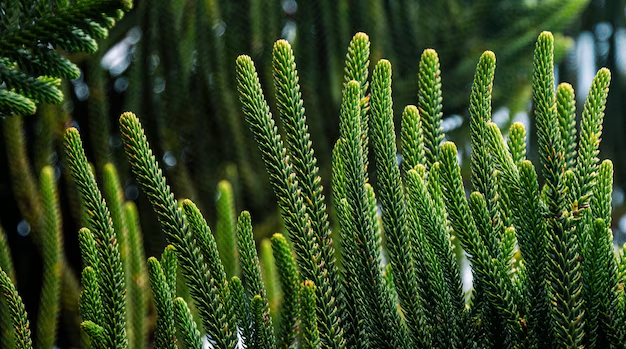When you first encounter a Norfolk Island Pine (Araucaria heterophylla), you might marvel at its striking appearance and wonder about its classification. Is it a monocot or dicot? Understanding whether this tree belongs to the monocot or dicot group provides insight into its unique biology, growth habits, and relationship to other plants. In this article, we’ll delve deep into the botanical classification of the Norfolk Island Pine and explain why it doesn’t fit neatly into the traditional monocot-dicot dichotomy.
What Is the Norfolk Island Pine?
The Norfolk Island Pine is a striking evergreen tree that is native to Norfolk Island, a small island in the South Pacific between Australia and New Zealand. While the Norfolk Island Pine may appear similar to a pine tree, it is not a true pine, nor is it even a member of the pine family (Pinaceae). Instead, it belongs to the Araucariaceae family, which includes other ancient and distinctive conifer species.
Despite its name and appearance, the Norfolk Island Pine is not closely related to any true pine species. It features a symmetrical, conical shape with soft, needle-like leaves arranged in whorls along the branches. It can grow to impressive heights both indoors and in its native habitat, making it a popular ornamental tree in temperate regions.
Monocot vs. Dicot: Understanding Plant Classification
To understand whether the Norfolk Island Pine is a monocot or dicot, it’s essential to first grasp the basic differences between these two categories of plants.
Monocots and dicots are the two primary divisions of flowering plants (angiosperms). These categories are based on the number of cotyledons (the first leaves that appear in a plant’s seed) and other distinguishing characteristics.
1. Monocots:
- Cotyledons: Monocots have one cotyledon.
- Leaf Veins: The veins in monocot leaves are typically parallel.
- Flower Petals: Monocots usually have flower parts in multiples of three.
- Vascular Tissue: The vascular bundles in monocots are scattered throughout the stem.
- Root Development: Monocots typically have fibrous root systems.
2. Dicots:
- Cotyledons: Dicots have two cotyledons.
- Leaf Veins: The veins in dicot leaves tend to form a branching pattern.
- Flower Petals: Dicots generally have flower parts in multiples of four or five.
- Vascular Tissue: In dicots, the vascular bundles form a ring in the stem.
- Root Development: Dicots tend to have taproot systems.
These characteristics are significant in identifying whether a plant is a monocot or dicot, but when it comes to conifers like the Norfolk Island Pine, this classification system does not apply as neatly.
The Norfolk Island Pine: A Conifer, Not an Angiosperm
The Norfolk Island Pine is a gymnosperm, not an angiosperm. Gymnosperms are seed-producing plants that do not flower, and they include conifers like pines, spruces, and firs, as well as other non-flowering trees such as cycads and ginkgos.
Unlike monocots and dicots, which are classifications for flowering plants (angiosperms), gymnosperms are characterized by their non-flowering nature and the way their seeds are exposed (rather than enclosed in fruits). This means the Norfolk Island Pine doesn’t fit into the traditional monocot-dicot classification system at all.
Key Differences Between Gymnosperms and Angiosperms:
| Feature | Gymnosperms (e.g., Norfolk Island Pine) | Angiosperms (Monocots & Dicots) |
| Seeds | Exposed seeds (not enclosed in a fruit) | Seeds enclosed within a fruit |
| Vascular Tissue | Xylem with tracheids (no vessel elements) | Xylem with vessel elements |
| Reproduction | Cones (male and female cones) | Flowers (male and female organs) |
| Leaf Structure | Needle-like leaves or scales | Broad leaves (usually) |
| Presence of Flowers | No flowers | Yes, flowers are present |
While the Norfolk Island Pine shares the “pine” moniker with species in the Pinaceae family, it is more closely related to other conifers within the Araucariaceae family, such as the Monkey Puzzle Tree (Araucaria araucana). Therefore, its classification is more aligned with gymnosperms, which include conifers like pines, firs, and spruces, rather than being categorized as either a monocot or dicot.
Why the Monocot/Dicot Classification Doesn’t Apply to the Norfolk Island Pine
The Norfolk Island Pine doesn’t fit into the monocot or dicot classification system for several important reasons:
- It Is Not an Angiosperm: As previously mentioned, the monocot and dicot classifications are exclusive to angiosperms (flowering plants). The Norfolk Island Pine, being a gymnosperm, does not produce flowers or fruits, so it is not part of these classifications.
- Different Evolutionary Lineage: Gymnosperms, including conifers like the Norfolk Island Pine, evolved long before angiosperms (the flowering plants). While angiosperms are classified based on seed structure and other factors, gymnosperms have a distinct evolutionary history and different characteristics, such as the way they produce seeds in exposed cones.
- Unique Botanical Characteristics: The Norfolk Island Pine has a number of features that distinguish it from monocots and dicots, including its reproductive structures (cones), needle-like leaves, and vascular tissue structure. These traits are more in line with those of conifers rather than the traits seen in monocots or dicots.
Norfolk Island Pine: More Than Just a Botanical Curiosity
While its classification might be confusing at first glance, the Norfolk Island Pine offers valuable lessons in understanding plant biology, evolutionary history, and ecological adaptations. This remarkable tree is not just a botanical anomaly; it serves as an important species in its native environment on Norfolk Island, where it contributes to local biodiversity.
Growing Norfolk Island Pine as an Indoor Tree
One of the reasons the Norfolk Island Pine has become so popular is its adaptability as an indoor tree. Whether you live in a tropical, subtropical, or temperate region, you can grow this tree as a houseplant, adding a touch of nature and elegance to your home.
If you’re thinking of growing a Norfolk Island Pine indoors, here are some tips:
- Light: Norfolk Island Pines need bright, indirect light. Direct sunlight can scorch their delicate needles.
- Watering: Keep the soil moderately moist. Ensure that the plant does not sit in water, as this can lead to root rot.
- Temperature: These trees thrive in temperatures between 60-75°F (15-24°C). Avoid placing them in areas with drafts or sudden temperature changes.
- Potting: Use a well-draining potting mix and ensure the pot has drainage holes to prevent water from accumulating at the bottom.
Norfolk Island Pine in Landscaping
In its natural habitat, the Norfolk Island Pine can grow to towering heights of over 200 feet (61 meters). As an ornamental tree, it is often planted in coastal and temperate regions around the world, particularly in areas that offer a mild climate. However, it’s important to note that in most places outside of its native environment, it may not reach its full height due to environmental factors.
Conclusion: The Norfolk Island Pine and Its Place in the Plant Kingdom
So, is the Norfolk Island Pine a monocot or dicot? The answer is neither. This tree is a gymnosperm, a type of plant that doesn’t fit into the conventional monocot or dicot classification system. Its evolutionary lineage, reproductive characteristics, and biological features align it more closely with other conifers than with flowering plants.
Though it may seem like a plant that doesn’t belong in any category, the Norfolk Island Pine is a beautiful and unique species that holds a special place in both the natural world and the hearts of plant enthusiasts. Whether you’re growing one as an indoor tree or admiring its beauty in the landscape, understanding its classification helps us appreciate this tree’s unique place in the plant kingdom.











